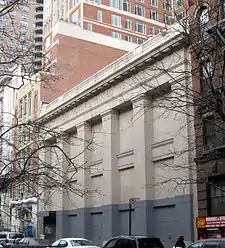Musical Mutual Protective Union
The Musical Mutual Protective Union (MMPU) was a New York union of musicians, formed in 1863, with a focus on payment made to musicians in theaters and at balls.[1][2][3]
 | |
| Founded | 1863 |
|---|---|
| Members | musicians |
| Affiliation | was Local 301 of the American Federation of Musicians from 1902–21 |
| Office location | 209 East 85th Street Manhattan, New York City |
| Country | United States |
In 1885, the union was open to “all instrumental performers, who have been residents of the United States for the period of six months previous to application.”[4] Foreign musicians were not allowed to play in orchestras unless they were in a union.[2]
The union become Local 301 of the American Federation of Musicians in 1902.[5] In 1904, it had 5,000 members, who were almost entirely German.[2][6] In 1910, approximately 300 black musicians were members in the roughly 8,000-member union.[4]
It was located at 209 East 85th Street in Manhattan, New York City, between Second Avenue and Third Avenue, in a building constructed in 1919.[5][6] The building was later a theater and hall, a casino, and a waiters' union.[4][5] The basement of the building now houses The Amsterdam Billiard Club.[5] The original facade on 85th Street is still extant.[5]
The union lost its charter in 1921.[5] In 1929 the union planned a mass march against joblessness, claiming 35,000 unemployed, but was unable to secure a parade permit from the police.[7][8]
References
- Spitzer, John (2012). American Orchestras in the Nineteenth Century. University of Chicago Pres. Retrieved June 10, 2014.
- Toff, Nancy (2005). Monarch of the Flute: The Life of Georges Barrere. Oxford University Press. Retrieved June 10, 2014.
- Executive Committee of the Musical Protective Union (November 13, 1865). "The Musical Mutual Protective Union – Card to the Public". The New York Times. Retrieved June 10, 2014.
- Goldberg, Jacob (February 11, 2013). "Breaking the color line; Associated Musicians of Greater New York". Local802afm.org. Retrieved June 10, 2014.
- Gray, Christopher (June 6, 1999). "Streetscapes: Readers' Questions; Echoes of a Union Hall; Artificial Sunlight". The New York Times. Retrieved June 10, 2014.
- Koegel, John (2009). Music in German Immigrant Theater: New York City, 1840–1940. University Rochester Press. Retrieved June 10, 2014.
- Zinn, Howard; Frank, Dana & Kelley, Robin D. G. (2002). Three Strikes: Miners, Musicians, Salesgirls, and the Fighting Spirit of Labor's Last Century. Beacon Press. p. 135. Retrieved June 10, 2014.
Musical Mutual Protective Union.
- Crafton, Donald (1999). The Talkies: American Cinema's Transition to Sound, 1926–1931. University of California Press. Retrieved June 10, 2014.
External links
- Constitution and By-laws of the Musical Mutual Protective Union: Local 310, A. F. of M. Founded April 23, 1863; Organized and Adopted June 26, 1864. Amended and Revised, Musical Mutual Protective Union, Machauer & Schmetterling (1905)